In-Depth Concept Analysis: Understanding Advanced Midwifery Practice
VerifiedAdded on 2023/06/11
|13
|3319
|390
Literature Review
AI Summary
This literature review provides a concept analysis of advanced midwifery practice (AMP), utilizing Rodgers' evolutionary method to clarify its mechanisms and attributes. It explores definitions, autonomous practice, leadership, expertise, and research skills associated with AMP. The review examines various titles and roles of AMPs, including clinical midwife specialists (CMS), and antecedents in countries like New Zealand, Australia, and South Africa. It highlights the consequences of AMP, such as increased CNM-attended births and reduced perinatal complications. The analysis identifies limitations, including language bias and lack of penalty assessments, while emphasizing the strength of the mixed-method approach. This document, contributed to Desklib, aims to enhance understanding of AMP and its implications in healthcare, offering valuable insights for students and professionals. Desklib provides additional study tools and resources to support further learning.
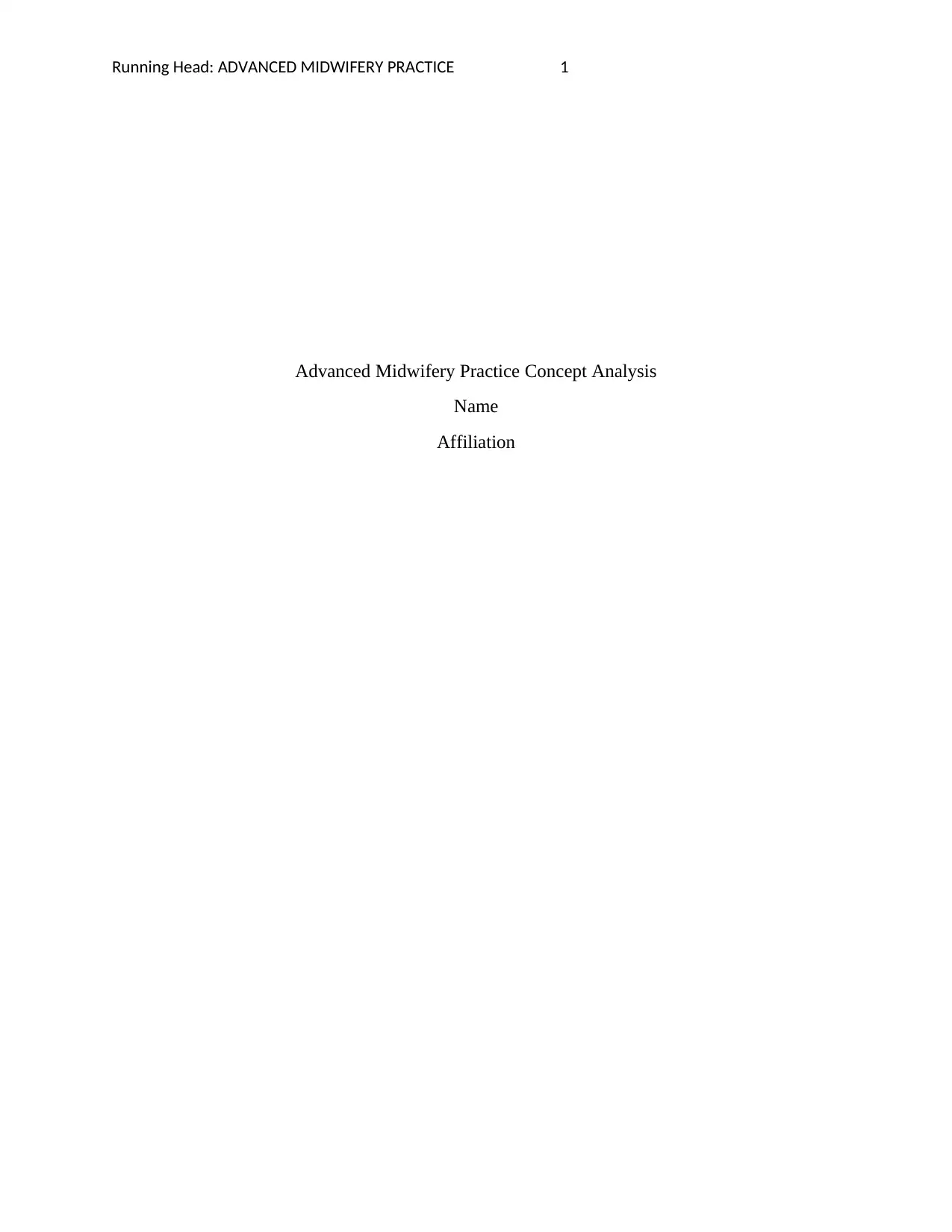
Running Head: ADVANCED MIDWIFERY PRACTICE 1
Advanced Midwifery Practice Concept Analysis
Name
Affiliation
Advanced Midwifery Practice Concept Analysis
Name
Affiliation
Secure Best Marks with AI Grader
Need help grading? Try our AI Grader for instant feedback on your assignments.
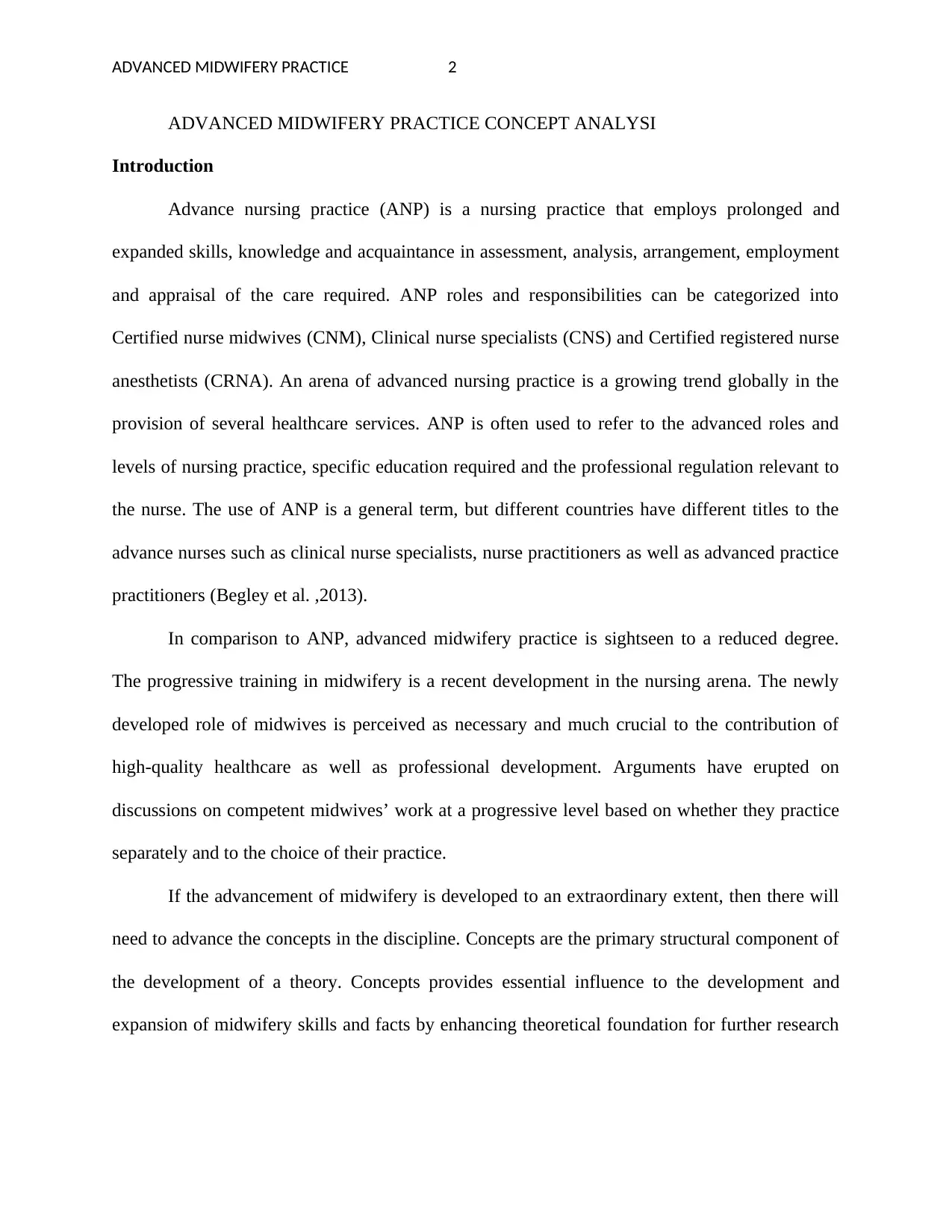
ADVANCED MIDWIFERY PRACTICE 2
ADVANCED MIDWIFERY PRACTICE CONCEPT ANALYSI
Introduction
Advance nursing practice (ANP) is a nursing practice that employs prolonged and
expanded skills, knowledge and acquaintance in assessment, analysis, arrangement, employment
and appraisal of the care required. ANP roles and responsibilities can be categorized into
Certified nurse midwives (CNM), Clinical nurse specialists (CNS) and Certified registered nurse
anesthetists (CRNA). An arena of advanced nursing practice is a growing trend globally in the
provision of several healthcare services. ANP is often used to refer to the advanced roles and
levels of nursing practice, specific education required and the professional regulation relevant to
the nurse. The use of ANP is a general term, but different countries have different titles to the
advance nurses such as clinical nurse specialists, nurse practitioners as well as advanced practice
practitioners (Begley et al. ,2013).
In comparison to ANP, advanced midwifery practice is sightseen to a reduced degree.
The progressive training in midwifery is a recent development in the nursing arena. The newly
developed role of midwives is perceived as necessary and much crucial to the contribution of
high-quality healthcare as well as professional development. Arguments have erupted on
discussions on competent midwives’ work at a progressive level based on whether they practice
separately and to the choice of their practice.
If the advancement of midwifery is developed to an extraordinary extent, then there will
need to advance the concepts in the discipline. Concepts are the primary structural component of
the development of a theory. Concepts provides essential influence to the development and
expansion of midwifery skills and facts by enhancing theoretical foundation for further research
ADVANCED MIDWIFERY PRACTICE CONCEPT ANALYSI
Introduction
Advance nursing practice (ANP) is a nursing practice that employs prolonged and
expanded skills, knowledge and acquaintance in assessment, analysis, arrangement, employment
and appraisal of the care required. ANP roles and responsibilities can be categorized into
Certified nurse midwives (CNM), Clinical nurse specialists (CNS) and Certified registered nurse
anesthetists (CRNA). An arena of advanced nursing practice is a growing trend globally in the
provision of several healthcare services. ANP is often used to refer to the advanced roles and
levels of nursing practice, specific education required and the professional regulation relevant to
the nurse. The use of ANP is a general term, but different countries have different titles to the
advance nurses such as clinical nurse specialists, nurse practitioners as well as advanced practice
practitioners (Begley et al. ,2013).
In comparison to ANP, advanced midwifery practice is sightseen to a reduced degree.
The progressive training in midwifery is a recent development in the nursing arena. The newly
developed role of midwives is perceived as necessary and much crucial to the contribution of
high-quality healthcare as well as professional development. Arguments have erupted on
discussions on competent midwives’ work at a progressive level based on whether they practice
separately and to the choice of their practice.
If the advancement of midwifery is developed to an extraordinary extent, then there will
need to advance the concepts in the discipline. Concepts are the primary structural component of
the development of a theory. Concepts provides essential influence to the development and
expansion of midwifery skills and facts by enhancing theoretical foundation for further research
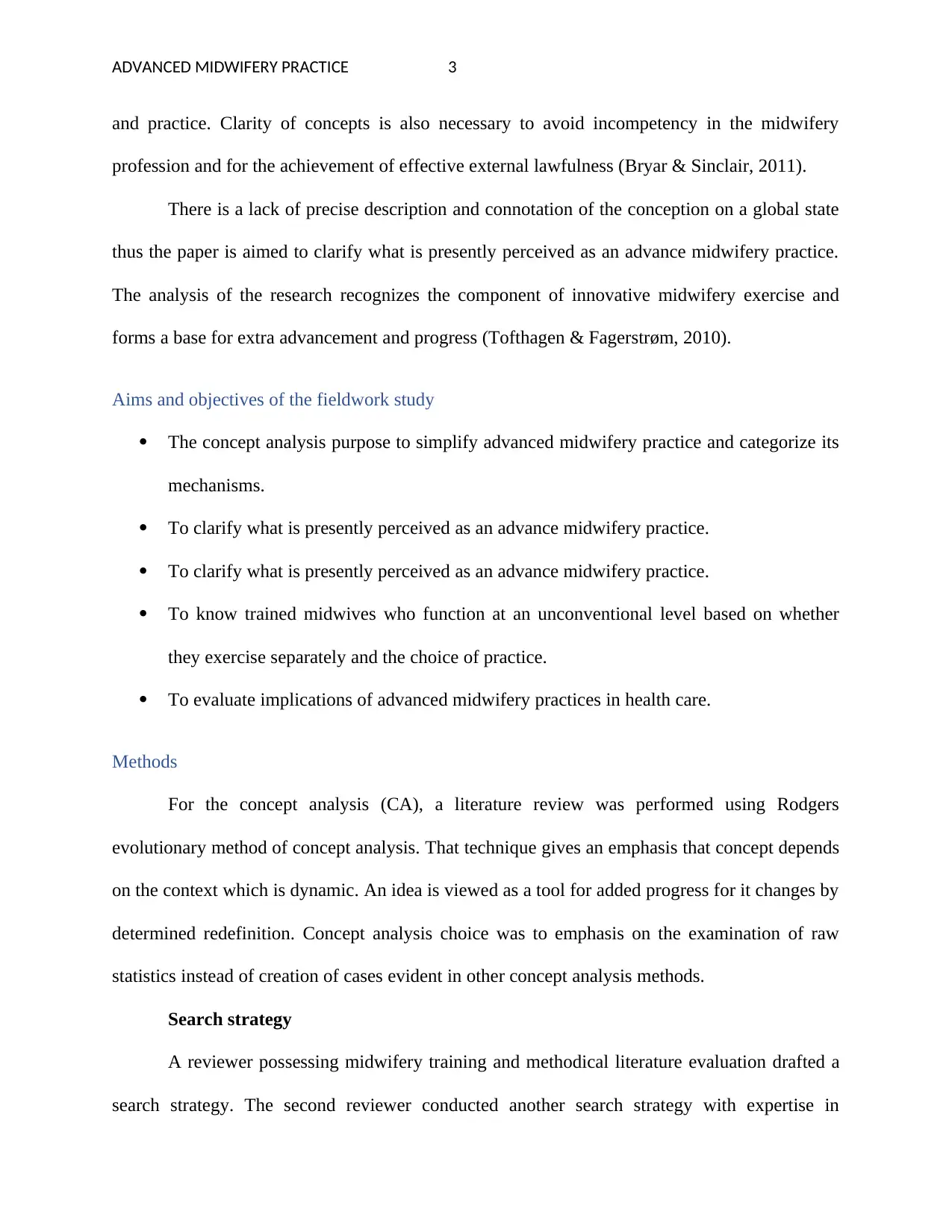
ADVANCED MIDWIFERY PRACTICE 3
and practice. Clarity of concepts is also necessary to avoid incompetency in the midwifery
profession and for the achievement of effective external lawfulness (Bryar & Sinclair, 2011).
There is a lack of precise description and connotation of the conception on a global state
thus the paper is aimed to clarify what is presently perceived as an advance midwifery practice.
The analysis of the research recognizes the component of innovative midwifery exercise and
forms a base for extra advancement and progress (Tofthagen & Fagerstrøm, 2010).
Aims and objectives of the fieldwork study
The concept analysis purpose to simplify advanced midwifery practice and categorize its
mechanisms.
To clarify what is presently perceived as an advance midwifery practice.
To clarify what is presently perceived as an advance midwifery practice.
To know trained midwives who function at an unconventional level based on whether
they exercise separately and the choice of practice.
To evaluate implications of advanced midwifery practices in health care.
Methods
For the concept analysis (CA), a literature review was performed using Rodgers
evolutionary method of concept analysis. That technique gives an emphasis that concept depends
on the context which is dynamic. An idea is viewed as a tool for added progress for it changes by
determined redefinition. Concept analysis choice was to emphasis on the examination of raw
statistics instead of creation of cases evident in other concept analysis methods.
Search strategy
A reviewer possessing midwifery training and methodical literature evaluation drafted a
search strategy. The second reviewer conducted another search strategy with expertise in
and practice. Clarity of concepts is also necessary to avoid incompetency in the midwifery
profession and for the achievement of effective external lawfulness (Bryar & Sinclair, 2011).
There is a lack of precise description and connotation of the conception on a global state
thus the paper is aimed to clarify what is presently perceived as an advance midwifery practice.
The analysis of the research recognizes the component of innovative midwifery exercise and
forms a base for extra advancement and progress (Tofthagen & Fagerstrøm, 2010).
Aims and objectives of the fieldwork study
The concept analysis purpose to simplify advanced midwifery practice and categorize its
mechanisms.
To clarify what is presently perceived as an advance midwifery practice.
To clarify what is presently perceived as an advance midwifery practice.
To know trained midwives who function at an unconventional level based on whether
they exercise separately and the choice of practice.
To evaluate implications of advanced midwifery practices in health care.
Methods
For the concept analysis (CA), a literature review was performed using Rodgers
evolutionary method of concept analysis. That technique gives an emphasis that concept depends
on the context which is dynamic. An idea is viewed as a tool for added progress for it changes by
determined redefinition. Concept analysis choice was to emphasis on the examination of raw
statistics instead of creation of cases evident in other concept analysis methods.
Search strategy
A reviewer possessing midwifery training and methodical literature evaluation drafted a
search strategy. The second reviewer conducted another search strategy with expertise in
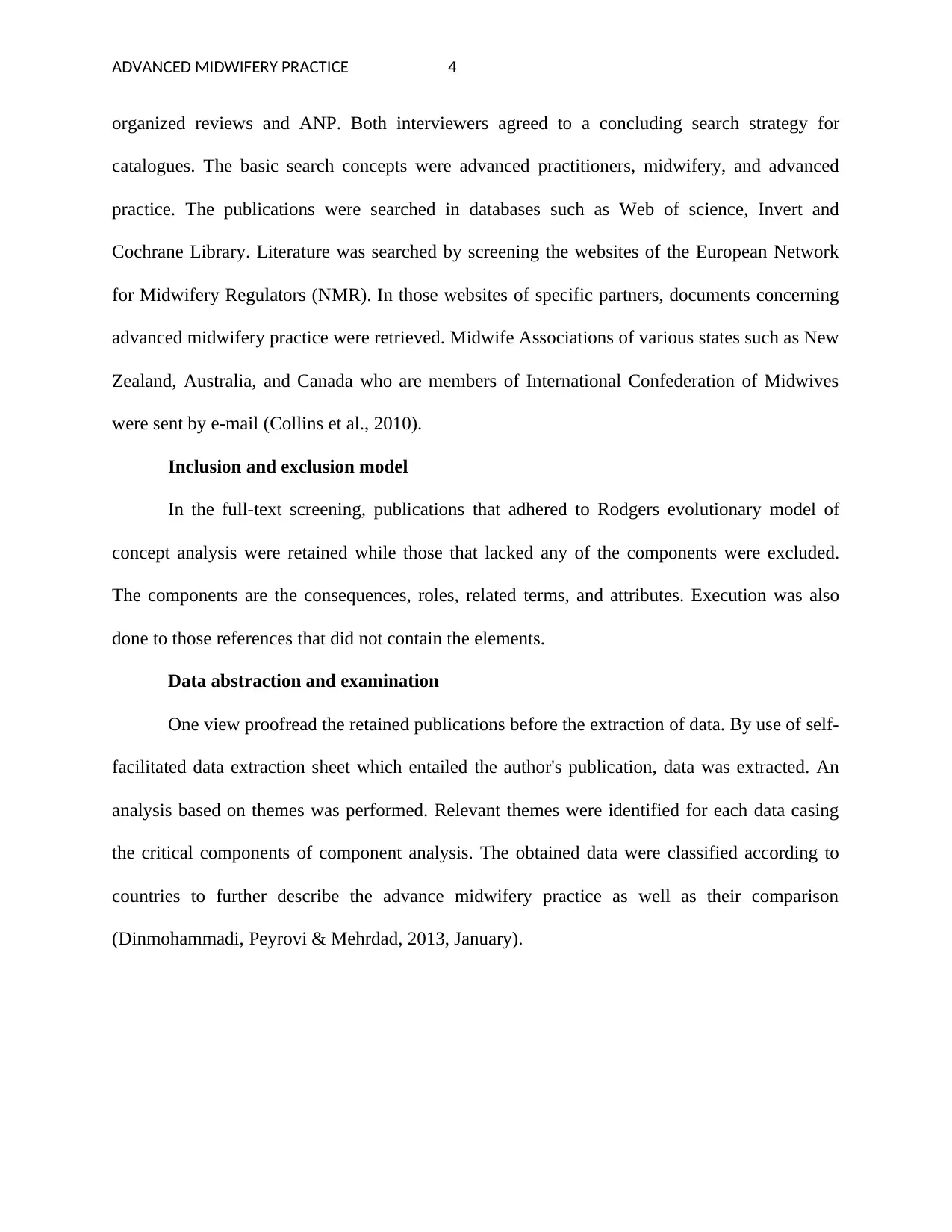
ADVANCED MIDWIFERY PRACTICE 4
organized reviews and ANP. Both interviewers agreed to a concluding search strategy for
catalogues. The basic search concepts were advanced practitioners, midwifery, and advanced
practice. The publications were searched in databases such as Web of science, Invert and
Cochrane Library. Literature was searched by screening the websites of the European Network
for Midwifery Regulators (NMR). In those websites of specific partners, documents concerning
advanced midwifery practice were retrieved. Midwife Associations of various states such as New
Zealand, Australia, and Canada who are members of International Confederation of Midwives
were sent by e-mail (Collins et al., 2010).
Inclusion and exclusion model
In the full-text screening, publications that adhered to Rodgers evolutionary model of
concept analysis were retained while those that lacked any of the components were excluded.
The components are the consequences, roles, related terms, and attributes. Execution was also
done to those references that did not contain the elements.
Data abstraction and examination
One view proofread the retained publications before the extraction of data. By use of self-
facilitated data extraction sheet which entailed the author's publication, data was extracted. An
analysis based on themes was performed. Relevant themes were identified for each data casing
the critical components of component analysis. The obtained data were classified according to
countries to further describe the advance midwifery practice as well as their comparison
(Dinmohammadi, Peyrovi & Mehrdad, 2013, January).
organized reviews and ANP. Both interviewers agreed to a concluding search strategy for
catalogues. The basic search concepts were advanced practitioners, midwifery, and advanced
practice. The publications were searched in databases such as Web of science, Invert and
Cochrane Library. Literature was searched by screening the websites of the European Network
for Midwifery Regulators (NMR). In those websites of specific partners, documents concerning
advanced midwifery practice were retrieved. Midwife Associations of various states such as New
Zealand, Australia, and Canada who are members of International Confederation of Midwives
were sent by e-mail (Collins et al., 2010).
Inclusion and exclusion model
In the full-text screening, publications that adhered to Rodgers evolutionary model of
concept analysis were retained while those that lacked any of the components were excluded.
The components are the consequences, roles, related terms, and attributes. Execution was also
done to those references that did not contain the elements.
Data abstraction and examination
One view proofread the retained publications before the extraction of data. By use of self-
facilitated data extraction sheet which entailed the author's publication, data was extracted. An
analysis based on themes was performed. Relevant themes were identified for each data casing
the critical components of component analysis. The obtained data were classified according to
countries to further describe the advance midwifery practice as well as their comparison
(Dinmohammadi, Peyrovi & Mehrdad, 2013, January).
Secure Best Marks with AI Grader
Need help grading? Try our AI Grader for instant feedback on your assignments.
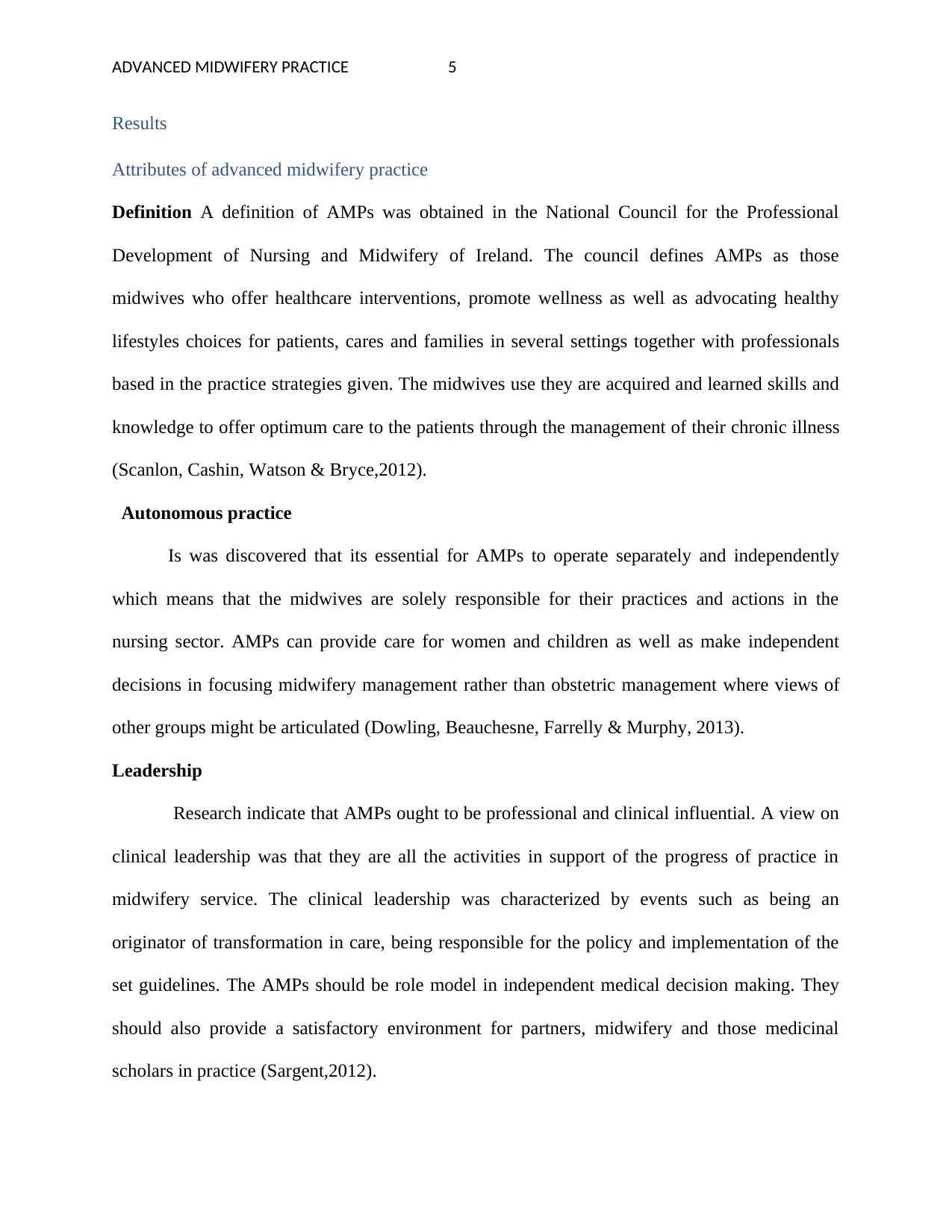
ADVANCED MIDWIFERY PRACTICE 5
Results
Attributes of advanced midwifery practice
Definition A definition of AMPs was obtained in the National Council for the Professional
Development of Nursing and Midwifery of Ireland. The council defines AMPs as those
midwives who offer healthcare interventions, promote wellness as well as advocating healthy
lifestyles choices for patients, cares and families in several settings together with professionals
based in the practice strategies given. The midwives use they are acquired and learned skills and
knowledge to offer optimum care to the patients through the management of their chronic illness
(Scanlon, Cashin, Watson & Bryce,2012).
Autonomous practice
Is was discovered that its essential for AMPs to operate separately and independently
which means that the midwives are solely responsible for their practices and actions in the
nursing sector. AMPs can provide care for women and children as well as make independent
decisions in focusing midwifery management rather than obstetric management where views of
other groups might be articulated (Dowling, Beauchesne, Farrelly & Murphy, 2013).
Leadership
Research indicate that AMPs ought to be professional and clinical influential. A view on
clinical leadership was that they are all the activities in support of the progress of practice in
midwifery service. The clinical leadership was characterized by events such as being an
originator of transformation in care, being responsible for the policy and implementation of the
set guidelines. The AMPs should be role model in independent medical decision making. They
should also provide a satisfactory environment for partners, midwifery and those medicinal
scholars in practice (Sargent,2012).
Results
Attributes of advanced midwifery practice
Definition A definition of AMPs was obtained in the National Council for the Professional
Development of Nursing and Midwifery of Ireland. The council defines AMPs as those
midwives who offer healthcare interventions, promote wellness as well as advocating healthy
lifestyles choices for patients, cares and families in several settings together with professionals
based in the practice strategies given. The midwives use they are acquired and learned skills and
knowledge to offer optimum care to the patients through the management of their chronic illness
(Scanlon, Cashin, Watson & Bryce,2012).
Autonomous practice
Is was discovered that its essential for AMPs to operate separately and independently
which means that the midwives are solely responsible for their practices and actions in the
nursing sector. AMPs can provide care for women and children as well as make independent
decisions in focusing midwifery management rather than obstetric management where views of
other groups might be articulated (Dowling, Beauchesne, Farrelly & Murphy, 2013).
Leadership
Research indicate that AMPs ought to be professional and clinical influential. A view on
clinical leadership was that they are all the activities in support of the progress of practice in
midwifery service. The clinical leadership was characterized by events such as being an
originator of transformation in care, being responsible for the policy and implementation of the
set guidelines. The AMPs should be role model in independent medical decision making. They
should also provide a satisfactory environment for partners, midwifery and those medicinal
scholars in practice (Sargent,2012).
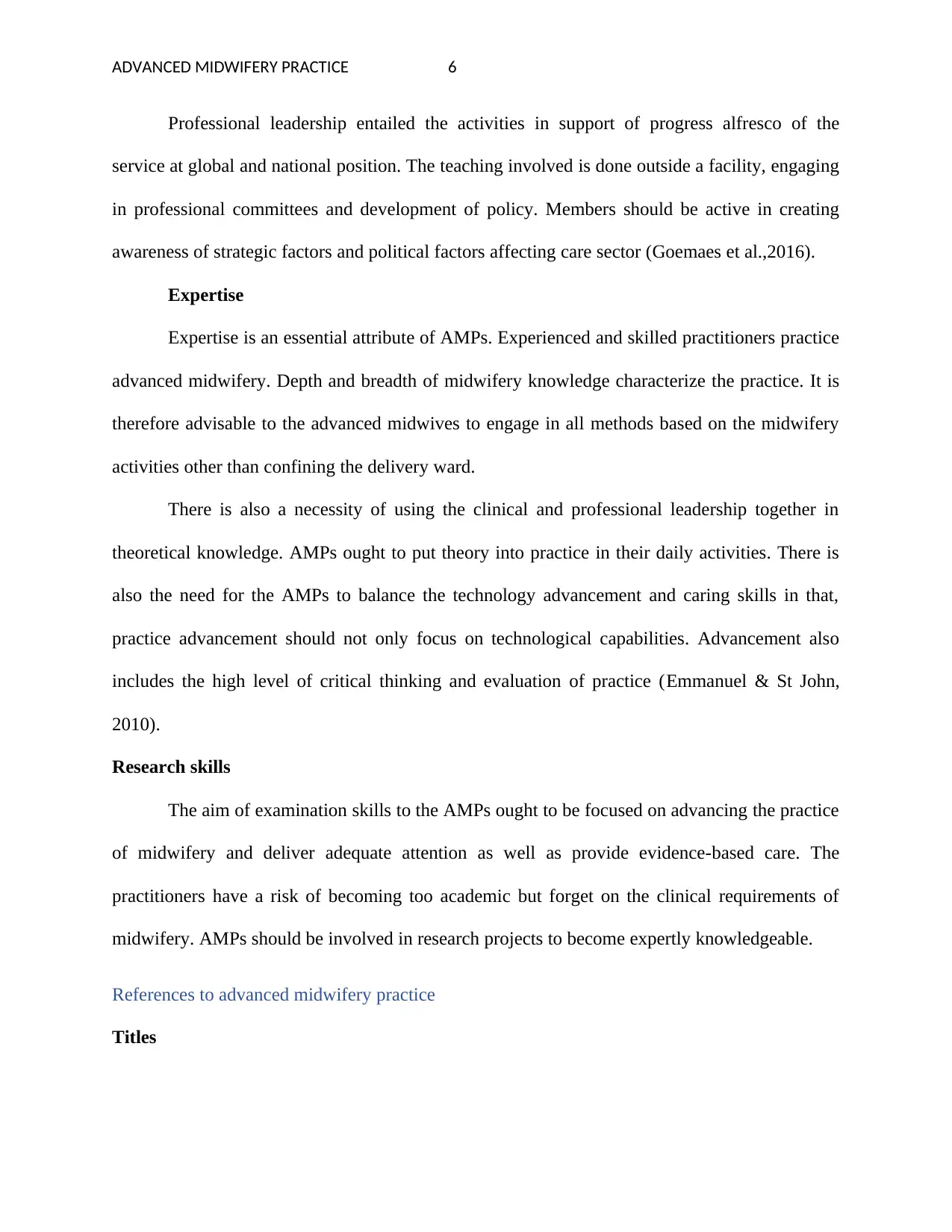
ADVANCED MIDWIFERY PRACTICE 6
Professional leadership entailed the activities in support of progress alfresco of the
service at global and national position. The teaching involved is done outside a facility, engaging
in professional committees and development of policy. Members should be active in creating
awareness of strategic factors and political factors affecting care sector (Goemaes et al.,2016).
Expertise
Expertise is an essential attribute of AMPs. Experienced and skilled practitioners practice
advanced midwifery. Depth and breadth of midwifery knowledge characterize the practice. It is
therefore advisable to the advanced midwives to engage in all methods based on the midwifery
activities other than confining the delivery ward.
There is also a necessity of using the clinical and professional leadership together in
theoretical knowledge. AMPs ought to put theory into practice in their daily activities. There is
also the need for the AMPs to balance the technology advancement and caring skills in that,
practice advancement should not only focus on technological capabilities. Advancement also
includes the high level of critical thinking and evaluation of practice (Emmanuel & St John,
2010).
Research skills
The aim of examination skills to the AMPs ought to be focused on advancing the practice
of midwifery and deliver adequate attention as well as provide evidence-based care. The
practitioners have a risk of becoming too academic but forget on the clinical requirements of
midwifery. AMPs should be involved in research projects to become expertly knowledgeable.
References to advanced midwifery practice
Titles
Professional leadership entailed the activities in support of progress alfresco of the
service at global and national position. The teaching involved is done outside a facility, engaging
in professional committees and development of policy. Members should be active in creating
awareness of strategic factors and political factors affecting care sector (Goemaes et al.,2016).
Expertise
Expertise is an essential attribute of AMPs. Experienced and skilled practitioners practice
advanced midwifery. Depth and breadth of midwifery knowledge characterize the practice. It is
therefore advisable to the advanced midwives to engage in all methods based on the midwifery
activities other than confining the delivery ward.
There is also a necessity of using the clinical and professional leadership together in
theoretical knowledge. AMPs ought to put theory into practice in their daily activities. There is
also the need for the AMPs to balance the technology advancement and caring skills in that,
practice advancement should not only focus on technological capabilities. Advancement also
includes the high level of critical thinking and evaluation of practice (Emmanuel & St John,
2010).
Research skills
The aim of examination skills to the AMPs ought to be focused on advancing the practice
of midwifery and deliver adequate attention as well as provide evidence-based care. The
practitioners have a risk of becoming too academic but forget on the clinical requirements of
midwifery. AMPs should be involved in research projects to become expertly knowledgeable.
References to advanced midwifery practice
Titles
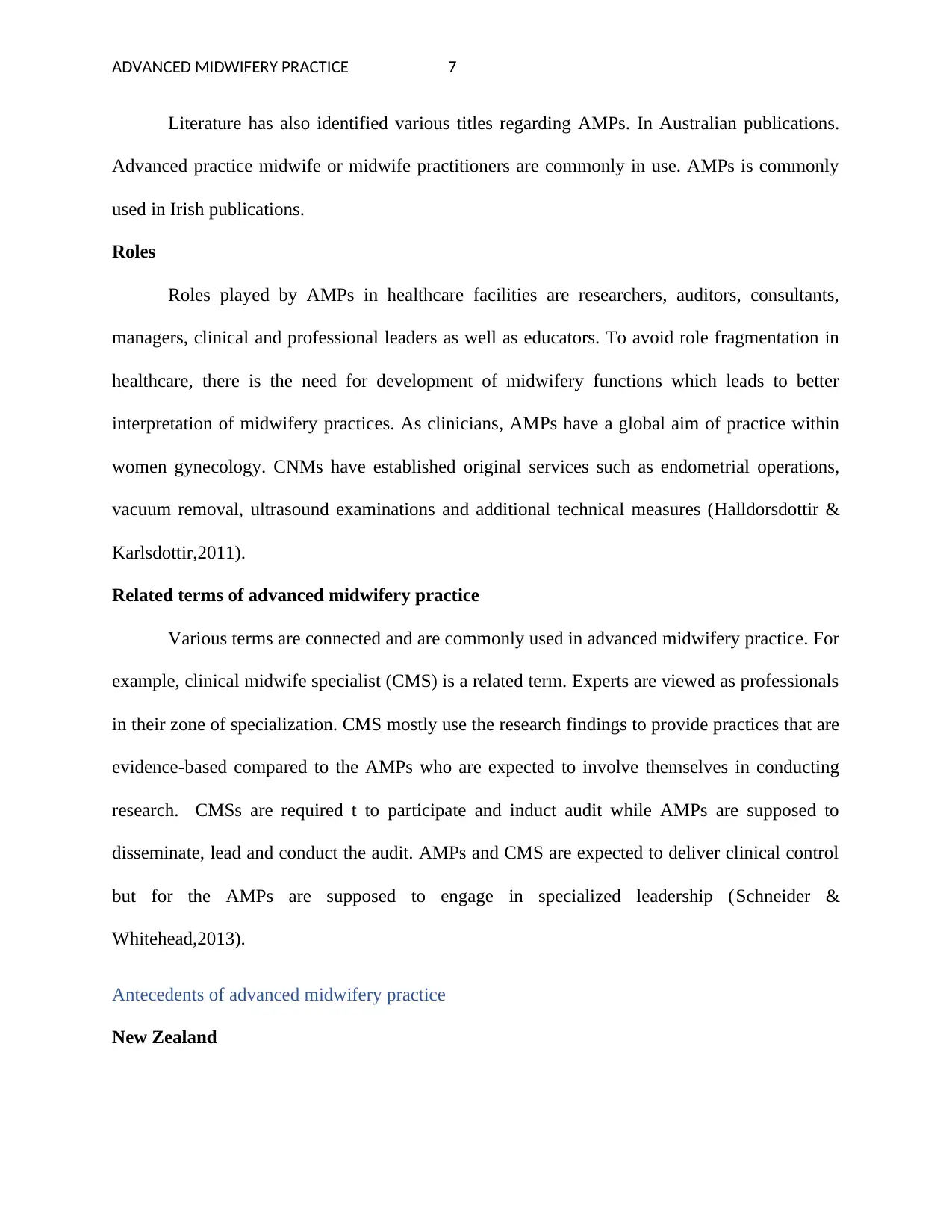
ADVANCED MIDWIFERY PRACTICE 7
Literature has also identified various titles regarding AMPs. In Australian publications.
Advanced practice midwife or midwife practitioners are commonly in use. AMPs is commonly
used in Irish publications.
Roles
Roles played by AMPs in healthcare facilities are researchers, auditors, consultants,
managers, clinical and professional leaders as well as educators. To avoid role fragmentation in
healthcare, there is the need for development of midwifery functions which leads to better
interpretation of midwifery practices. As clinicians, AMPs have a global aim of practice within
women gynecology. CNMs have established original services such as endometrial operations,
vacuum removal, ultrasound examinations and additional technical measures (Halldorsdottir &
Karlsdottir,2011).
Related terms of advanced midwifery practice
Various terms are connected and are commonly used in advanced midwifery practice. For
example, clinical midwife specialist (CMS) is a related term. Experts are viewed as professionals
in their zone of specialization. CMS mostly use the research findings to provide practices that are
evidence-based compared to the AMPs who are expected to involve themselves in conducting
research. CMSs are required t to participate and induct audit while AMPs are supposed to
disseminate, lead and conduct the audit. AMPs and CMS are expected to deliver clinical control
but for the AMPs are supposed to engage in specialized leadership (Schneider &
Whitehead,2013).
Antecedents of advanced midwifery practice
New Zealand
Literature has also identified various titles regarding AMPs. In Australian publications.
Advanced practice midwife or midwife practitioners are commonly in use. AMPs is commonly
used in Irish publications.
Roles
Roles played by AMPs in healthcare facilities are researchers, auditors, consultants,
managers, clinical and professional leaders as well as educators. To avoid role fragmentation in
healthcare, there is the need for development of midwifery functions which leads to better
interpretation of midwifery practices. As clinicians, AMPs have a global aim of practice within
women gynecology. CNMs have established original services such as endometrial operations,
vacuum removal, ultrasound examinations and additional technical measures (Halldorsdottir &
Karlsdottir,2011).
Related terms of advanced midwifery practice
Various terms are connected and are commonly used in advanced midwifery practice. For
example, clinical midwife specialist (CMS) is a related term. Experts are viewed as professionals
in their zone of specialization. CMS mostly use the research findings to provide practices that are
evidence-based compared to the AMPs who are expected to involve themselves in conducting
research. CMSs are required t to participate and induct audit while AMPs are supposed to
disseminate, lead and conduct the audit. AMPs and CMS are expected to deliver clinical control
but for the AMPs are supposed to engage in specialized leadership (Schneider &
Whitehead,2013).
Antecedents of advanced midwifery practice
New Zealand
Paraphrase This Document
Need a fresh take? Get an instant paraphrase of this document with our AI Paraphraser
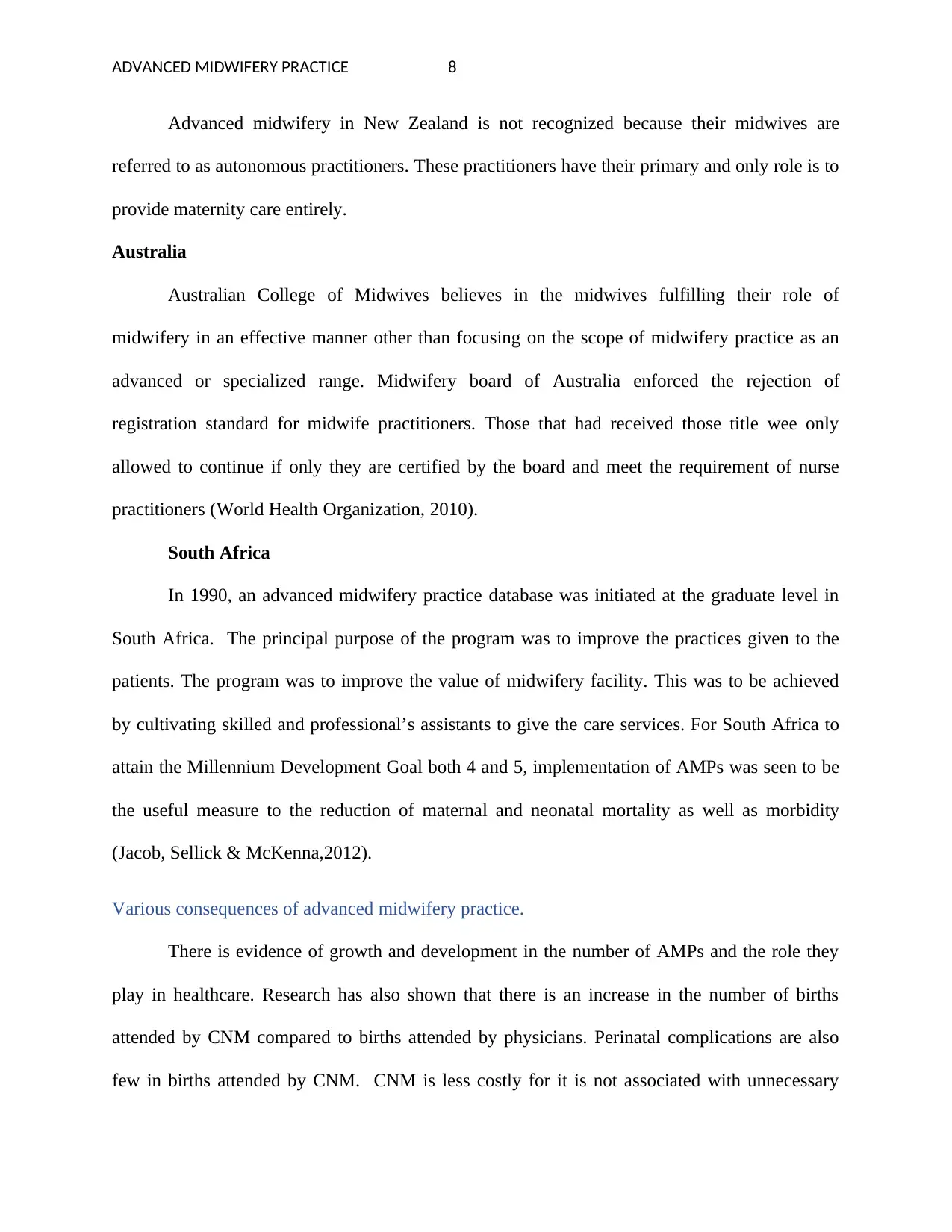
ADVANCED MIDWIFERY PRACTICE 8
Advanced midwifery in New Zealand is not recognized because their midwives are
referred to as autonomous practitioners. These practitioners have their primary and only role is to
provide maternity care entirely.
Australia
Australian College of Midwives believes in the midwives fulfilling their role of
midwifery in an effective manner other than focusing on the scope of midwifery practice as an
advanced or specialized range. Midwifery board of Australia enforced the rejection of
registration standard for midwife practitioners. Those that had received those title wee only
allowed to continue if only they are certified by the board and meet the requirement of nurse
practitioners (World Health Organization, 2010).
South Africa
In 1990, an advanced midwifery practice database was initiated at the graduate level in
South Africa. The principal purpose of the program was to improve the practices given to the
patients. The program was to improve the value of midwifery facility. This was to be achieved
by cultivating skilled and professional’s assistants to give the care services. For South Africa to
attain the Millennium Development Goal both 4 and 5, implementation of AMPs was seen to be
the useful measure to the reduction of maternal and neonatal mortality as well as morbidity
(Jacob, Sellick & McKenna,2012).
Various consequences of advanced midwifery practice.
There is evidence of growth and development in the number of AMPs and the role they
play in healthcare. Research has also shown that there is an increase in the number of births
attended by CNM compared to births attended by physicians. Perinatal complications are also
few in births attended by CNM. CNM is less costly for it is not associated with unnecessary
Advanced midwifery in New Zealand is not recognized because their midwives are
referred to as autonomous practitioners. These practitioners have their primary and only role is to
provide maternity care entirely.
Australia
Australian College of Midwives believes in the midwives fulfilling their role of
midwifery in an effective manner other than focusing on the scope of midwifery practice as an
advanced or specialized range. Midwifery board of Australia enforced the rejection of
registration standard for midwife practitioners. Those that had received those title wee only
allowed to continue if only they are certified by the board and meet the requirement of nurse
practitioners (World Health Organization, 2010).
South Africa
In 1990, an advanced midwifery practice database was initiated at the graduate level in
South Africa. The principal purpose of the program was to improve the practices given to the
patients. The program was to improve the value of midwifery facility. This was to be achieved
by cultivating skilled and professional’s assistants to give the care services. For South Africa to
attain the Millennium Development Goal both 4 and 5, implementation of AMPs was seen to be
the useful measure to the reduction of maternal and neonatal mortality as well as morbidity
(Jacob, Sellick & McKenna,2012).
Various consequences of advanced midwifery practice.
There is evidence of growth and development in the number of AMPs and the role they
play in healthcare. Research has also shown that there is an increase in the number of births
attended by CNM compared to births attended by physicians. Perinatal complications are also
few in births attended by CNM. CNM is less costly for it is not associated with unnecessary
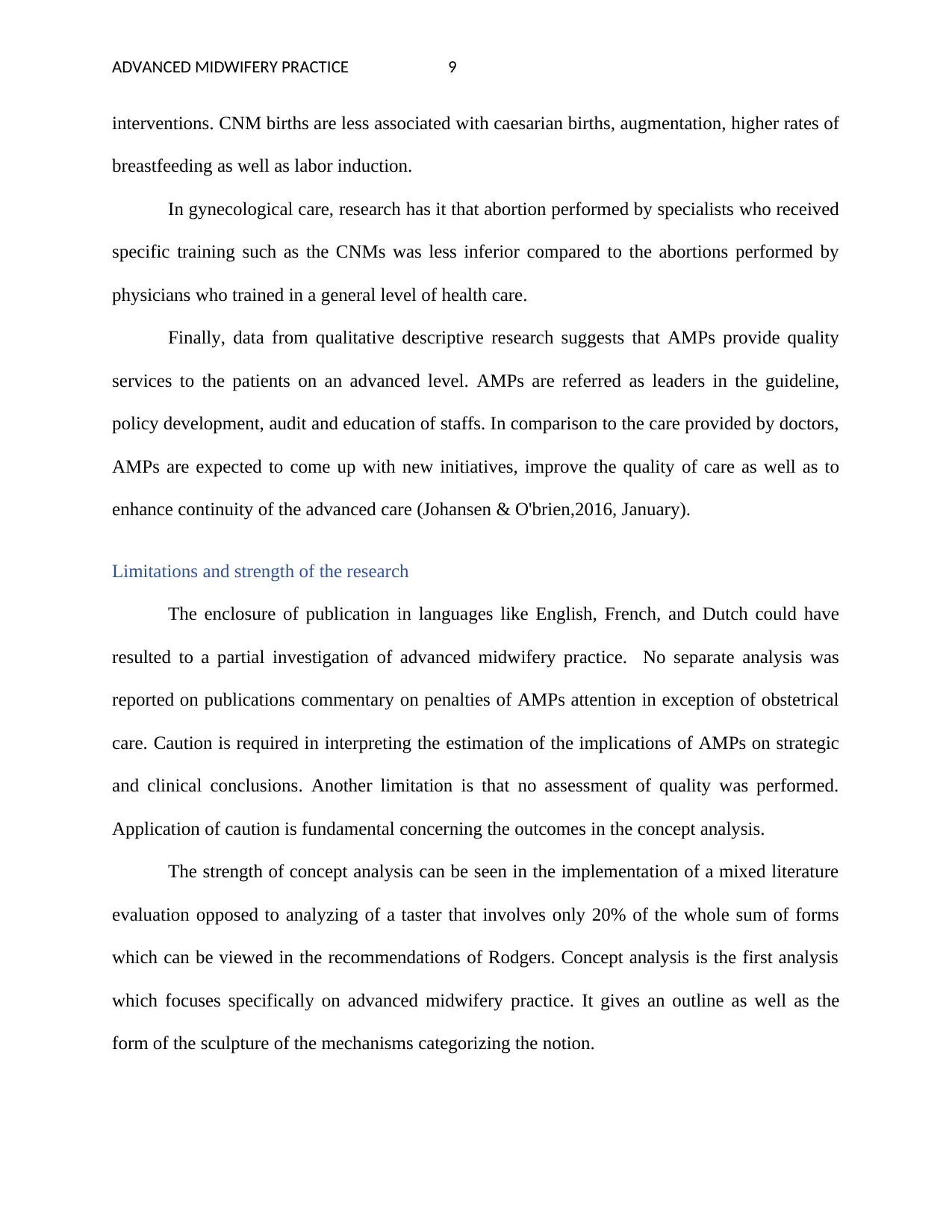
ADVANCED MIDWIFERY PRACTICE 9
interventions. CNM births are less associated with caesarian births, augmentation, higher rates of
breastfeeding as well as labor induction.
In gynecological care, research has it that abortion performed by specialists who received
specific training such as the CNMs was less inferior compared to the abortions performed by
physicians who trained in a general level of health care.
Finally, data from qualitative descriptive research suggests that AMPs provide quality
services to the patients on an advanced level. AMPs are referred as leaders in the guideline,
policy development, audit and education of staffs. In comparison to the care provided by doctors,
AMPs are expected to come up with new initiatives, improve the quality of care as well as to
enhance continuity of the advanced care (Johansen & O'brien,2016, January).
Limitations and strength of the research
The enclosure of publication in languages like English, French, and Dutch could have
resulted to a partial investigation of advanced midwifery practice. No separate analysis was
reported on publications commentary on penalties of AMPs attention in exception of obstetrical
care. Caution is required in interpreting the estimation of the implications of AMPs on strategic
and clinical conclusions. Another limitation is that no assessment of quality was performed.
Application of caution is fundamental concerning the outcomes in the concept analysis.
The strength of concept analysis can be seen in the implementation of a mixed literature
evaluation opposed to analyzing of a taster that involves only 20% of the whole sum of forms
which can be viewed in the recommendations of Rodgers. Concept analysis is the first analysis
which focuses specifically on advanced midwifery practice. It gives an outline as well as the
form of the sculpture of the mechanisms categorizing the notion.
interventions. CNM births are less associated with caesarian births, augmentation, higher rates of
breastfeeding as well as labor induction.
In gynecological care, research has it that abortion performed by specialists who received
specific training such as the CNMs was less inferior compared to the abortions performed by
physicians who trained in a general level of health care.
Finally, data from qualitative descriptive research suggests that AMPs provide quality
services to the patients on an advanced level. AMPs are referred as leaders in the guideline,
policy development, audit and education of staffs. In comparison to the care provided by doctors,
AMPs are expected to come up with new initiatives, improve the quality of care as well as to
enhance continuity of the advanced care (Johansen & O'brien,2016, January).
Limitations and strength of the research
The enclosure of publication in languages like English, French, and Dutch could have
resulted to a partial investigation of advanced midwifery practice. No separate analysis was
reported on publications commentary on penalties of AMPs attention in exception of obstetrical
care. Caution is required in interpreting the estimation of the implications of AMPs on strategic
and clinical conclusions. Another limitation is that no assessment of quality was performed.
Application of caution is fundamental concerning the outcomes in the concept analysis.
The strength of concept analysis can be seen in the implementation of a mixed literature
evaluation opposed to analyzing of a taster that involves only 20% of the whole sum of forms
which can be viewed in the recommendations of Rodgers. Concept analysis is the first analysis
which focuses specifically on advanced midwifery practice. It gives an outline as well as the
form of the sculpture of the mechanisms categorizing the notion.
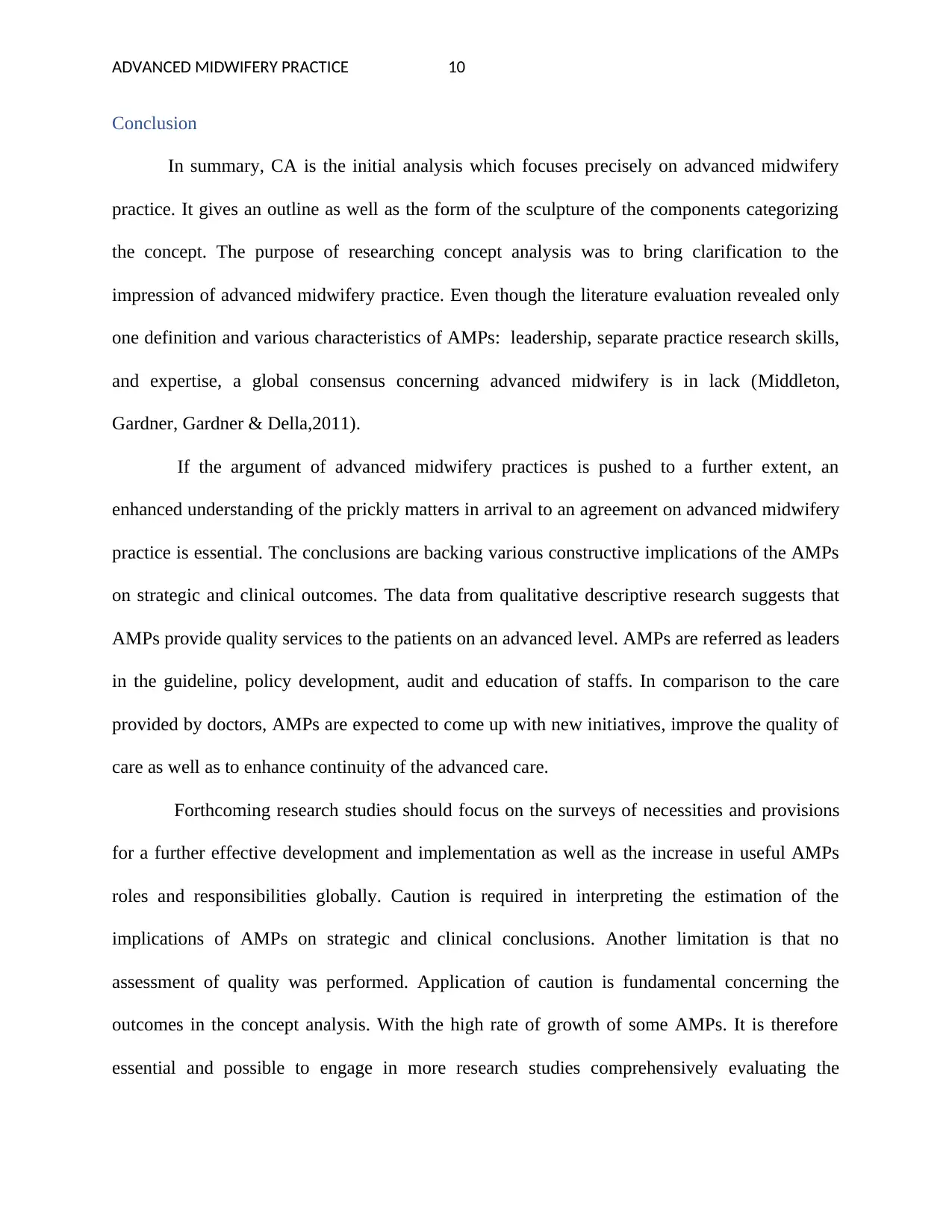
ADVANCED MIDWIFERY PRACTICE 10
Conclusion
In summary, CA is the initial analysis which focuses precisely on advanced midwifery
practice. It gives an outline as well as the form of the sculpture of the components categorizing
the concept. The purpose of researching concept analysis was to bring clarification to the
impression of advanced midwifery practice. Even though the literature evaluation revealed only
one definition and various characteristics of AMPs: leadership, separate practice research skills,
and expertise, a global consensus concerning advanced midwifery is in lack (Middleton,
Gardner, Gardner & Della,2011).
If the argument of advanced midwifery practices is pushed to a further extent, an
enhanced understanding of the prickly matters in arrival to an agreement on advanced midwifery
practice is essential. The conclusions are backing various constructive implications of the AMPs
on strategic and clinical outcomes. The data from qualitative descriptive research suggests that
AMPs provide quality services to the patients on an advanced level. AMPs are referred as leaders
in the guideline, policy development, audit and education of staffs. In comparison to the care
provided by doctors, AMPs are expected to come up with new initiatives, improve the quality of
care as well as to enhance continuity of the advanced care.
Forthcoming research studies should focus on the surveys of necessities and provisions
for a further effective development and implementation as well as the increase in useful AMPs
roles and responsibilities globally. Caution is required in interpreting the estimation of the
implications of AMPs on strategic and clinical conclusions. Another limitation is that no
assessment of quality was performed. Application of caution is fundamental concerning the
outcomes in the concept analysis. With the high rate of growth of some AMPs. It is therefore
essential and possible to engage in more research studies comprehensively evaluating the
Conclusion
In summary, CA is the initial analysis which focuses precisely on advanced midwifery
practice. It gives an outline as well as the form of the sculpture of the components categorizing
the concept. The purpose of researching concept analysis was to bring clarification to the
impression of advanced midwifery practice. Even though the literature evaluation revealed only
one definition and various characteristics of AMPs: leadership, separate practice research skills,
and expertise, a global consensus concerning advanced midwifery is in lack (Middleton,
Gardner, Gardner & Della,2011).
If the argument of advanced midwifery practices is pushed to a further extent, an
enhanced understanding of the prickly matters in arrival to an agreement on advanced midwifery
practice is essential. The conclusions are backing various constructive implications of the AMPs
on strategic and clinical outcomes. The data from qualitative descriptive research suggests that
AMPs provide quality services to the patients on an advanced level. AMPs are referred as leaders
in the guideline, policy development, audit and education of staffs. In comparison to the care
provided by doctors, AMPs are expected to come up with new initiatives, improve the quality of
care as well as to enhance continuity of the advanced care.
Forthcoming research studies should focus on the surveys of necessities and provisions
for a further effective development and implementation as well as the increase in useful AMPs
roles and responsibilities globally. Caution is required in interpreting the estimation of the
implications of AMPs on strategic and clinical conclusions. Another limitation is that no
assessment of quality was performed. Application of caution is fundamental concerning the
outcomes in the concept analysis. With the high rate of growth of some AMPs. It is therefore
essential and possible to engage in more research studies comprehensively evaluating the
Secure Best Marks with AI Grader
Need help grading? Try our AI Grader for instant feedback on your assignments.
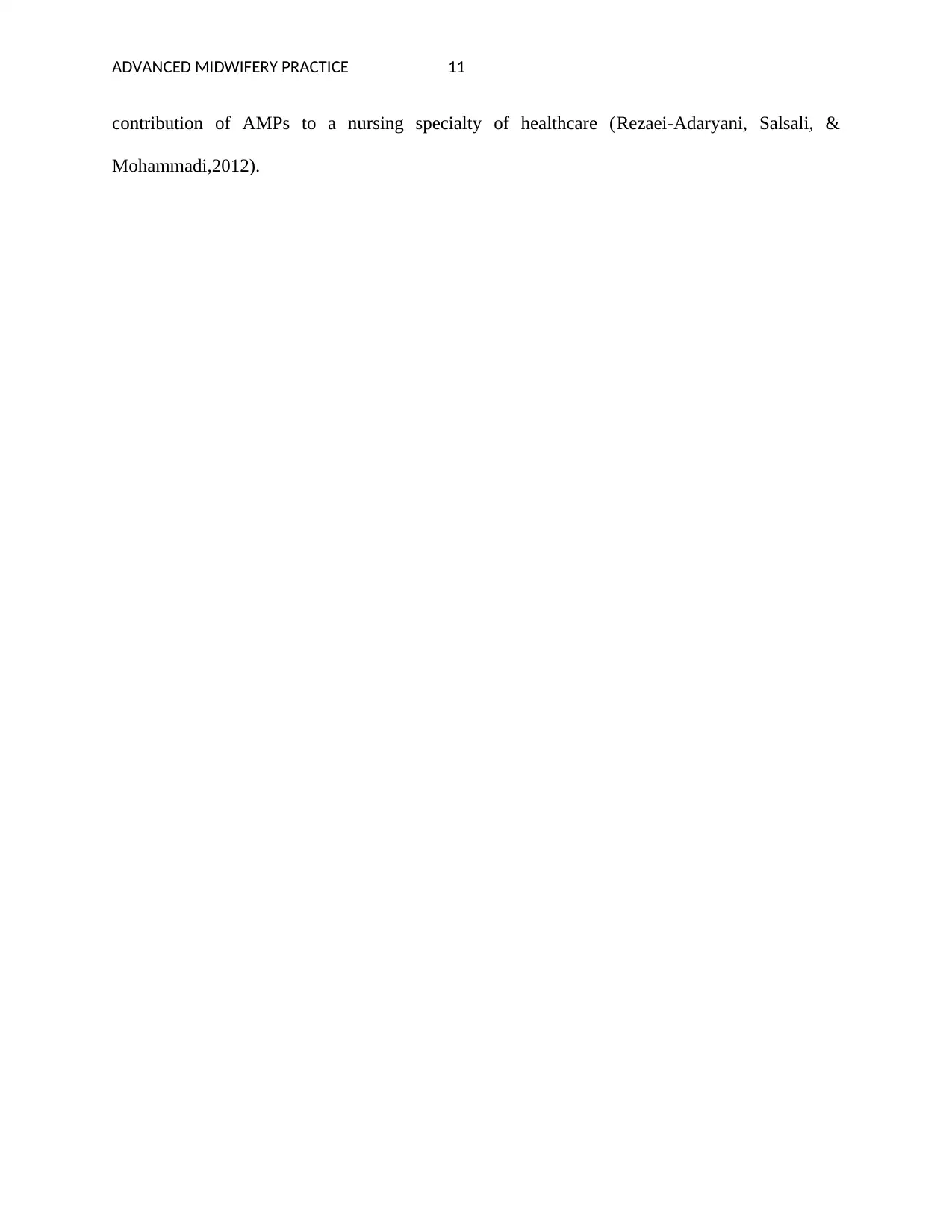
ADVANCED MIDWIFERY PRACTICE 11
contribution of AMPs to a nursing specialty of healthcare (Rezaei-Adaryani, Salsali, &
Mohammadi,2012).
contribution of AMPs to a nursing specialty of healthcare (Rezaei-Adaryani, Salsali, &
Mohammadi,2012).
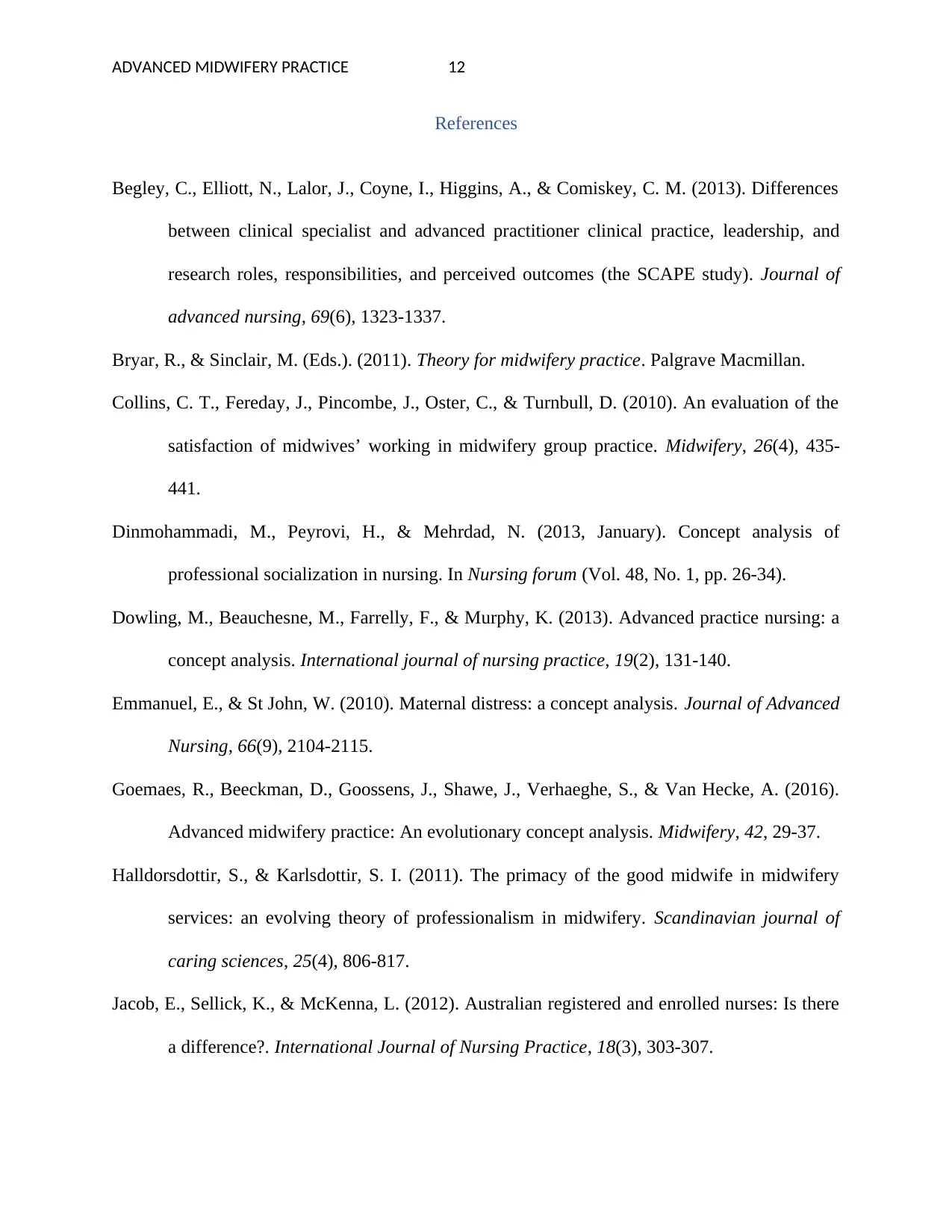
ADVANCED MIDWIFERY PRACTICE 12
References
Begley, C., Elliott, N., Lalor, J., Coyne, I., Higgins, A., & Comiskey, C. M. (2013). Differences
between clinical specialist and advanced practitioner clinical practice, leadership, and
research roles, responsibilities, and perceived outcomes (the SCAPE study). Journal of
advanced nursing, 69(6), 1323-1337.
Bryar, R., & Sinclair, M. (Eds.). (2011). Theory for midwifery practice. Palgrave Macmillan.
Collins, C. T., Fereday, J., Pincombe, J., Oster, C., & Turnbull, D. (2010). An evaluation of the
satisfaction of midwives’ working in midwifery group practice. Midwifery, 26(4), 435-
441.
Dinmohammadi, M., Peyrovi, H., & Mehrdad, N. (2013, January). Concept analysis of
professional socialization in nursing. In Nursing forum (Vol. 48, No. 1, pp. 26-34).
Dowling, M., Beauchesne, M., Farrelly, F., & Murphy, K. (2013). Advanced practice nursing: a
concept analysis. International journal of nursing practice, 19(2), 131-140.
Emmanuel, E., & St John, W. (2010). Maternal distress: a concept analysis. Journal of Advanced
Nursing, 66(9), 2104-2115.
Goemaes, R., Beeckman, D., Goossens, J., Shawe, J., Verhaeghe, S., & Van Hecke, A. (2016).
Advanced midwifery practice: An evolutionary concept analysis. Midwifery, 42, 29-37.
Halldorsdottir, S., & Karlsdottir, S. I. (2011). The primacy of the good midwife in midwifery
services: an evolving theory of professionalism in midwifery. Scandinavian journal of
caring sciences, 25(4), 806-817.
Jacob, E., Sellick, K., & McKenna, L. (2012). Australian registered and enrolled nurses: Is there
a difference?. International Journal of Nursing Practice, 18(3), 303-307.
References
Begley, C., Elliott, N., Lalor, J., Coyne, I., Higgins, A., & Comiskey, C. M. (2013). Differences
between clinical specialist and advanced practitioner clinical practice, leadership, and
research roles, responsibilities, and perceived outcomes (the SCAPE study). Journal of
advanced nursing, 69(6), 1323-1337.
Bryar, R., & Sinclair, M. (Eds.). (2011). Theory for midwifery practice. Palgrave Macmillan.
Collins, C. T., Fereday, J., Pincombe, J., Oster, C., & Turnbull, D. (2010). An evaluation of the
satisfaction of midwives’ working in midwifery group practice. Midwifery, 26(4), 435-
441.
Dinmohammadi, M., Peyrovi, H., & Mehrdad, N. (2013, January). Concept analysis of
professional socialization in nursing. In Nursing forum (Vol. 48, No. 1, pp. 26-34).
Dowling, M., Beauchesne, M., Farrelly, F., & Murphy, K. (2013). Advanced practice nursing: a
concept analysis. International journal of nursing practice, 19(2), 131-140.
Emmanuel, E., & St John, W. (2010). Maternal distress: a concept analysis. Journal of Advanced
Nursing, 66(9), 2104-2115.
Goemaes, R., Beeckman, D., Goossens, J., Shawe, J., Verhaeghe, S., & Van Hecke, A. (2016).
Advanced midwifery practice: An evolutionary concept analysis. Midwifery, 42, 29-37.
Halldorsdottir, S., & Karlsdottir, S. I. (2011). The primacy of the good midwife in midwifery
services: an evolving theory of professionalism in midwifery. Scandinavian journal of
caring sciences, 25(4), 806-817.
Jacob, E., Sellick, K., & McKenna, L. (2012). Australian registered and enrolled nurses: Is there
a difference?. International Journal of Nursing Practice, 18(3), 303-307.
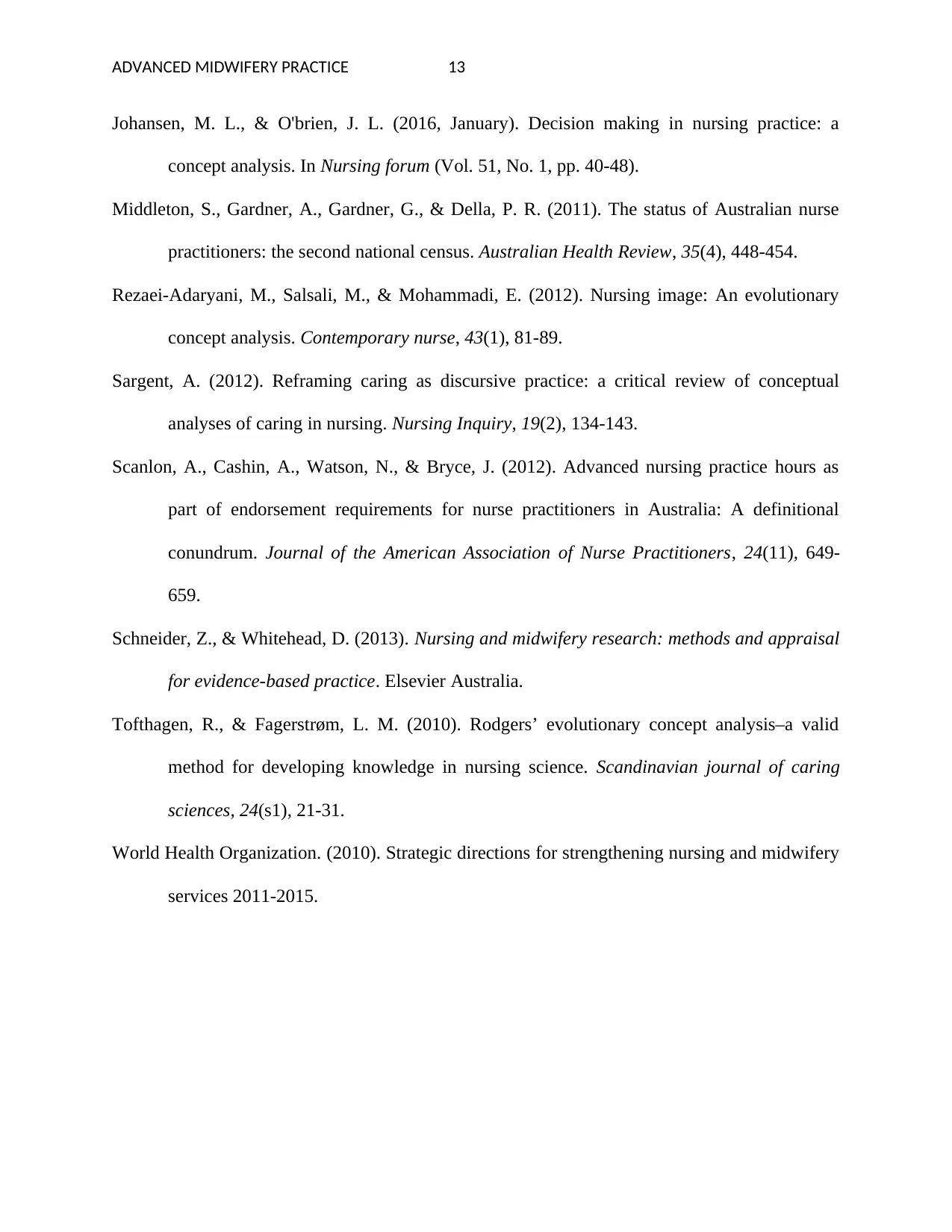
ADVANCED MIDWIFERY PRACTICE 13
Johansen, M. L., & O'brien, J. L. (2016, January). Decision making in nursing practice: a
concept analysis. In Nursing forum (Vol. 51, No. 1, pp. 40-48).
Middleton, S., Gardner, A., Gardner, G., & Della, P. R. (2011). The status of Australian nurse
practitioners: the second national census. Australian Health Review, 35(4), 448-454.
Rezaei-Adaryani, M., Salsali, M., & Mohammadi, E. (2012). Nursing image: An evolutionary
concept analysis. Contemporary nurse, 43(1), 81-89.
Sargent, A. (2012). Reframing caring as discursive practice: a critical review of conceptual
analyses of caring in nursing. Nursing Inquiry, 19(2), 134-143.
Scanlon, A., Cashin, A., Watson, N., & Bryce, J. (2012). Advanced nursing practice hours as
part of endorsement requirements for nurse practitioners in Australia: A definitional
conundrum. Journal of the American Association of Nurse Practitioners, 24(11), 649-
659.
Schneider, Z., & Whitehead, D. (2013). Nursing and midwifery research: methods and appraisal
for evidence-based practice. Elsevier Australia.
Tofthagen, R., & Fagerstrøm, L. M. (2010). Rodgers’ evolutionary concept analysis–a valid
method for developing knowledge in nursing science. Scandinavian journal of caring
sciences, 24(s1), 21-31.
World Health Organization. (2010). Strategic directions for strengthening nursing and midwifery
services 2011-2015.
Johansen, M. L., & O'brien, J. L. (2016, January). Decision making in nursing practice: a
concept analysis. In Nursing forum (Vol. 51, No. 1, pp. 40-48).
Middleton, S., Gardner, A., Gardner, G., & Della, P. R. (2011). The status of Australian nurse
practitioners: the second national census. Australian Health Review, 35(4), 448-454.
Rezaei-Adaryani, M., Salsali, M., & Mohammadi, E. (2012). Nursing image: An evolutionary
concept analysis. Contemporary nurse, 43(1), 81-89.
Sargent, A. (2012). Reframing caring as discursive practice: a critical review of conceptual
analyses of caring in nursing. Nursing Inquiry, 19(2), 134-143.
Scanlon, A., Cashin, A., Watson, N., & Bryce, J. (2012). Advanced nursing practice hours as
part of endorsement requirements for nurse practitioners in Australia: A definitional
conundrum. Journal of the American Association of Nurse Practitioners, 24(11), 649-
659.
Schneider, Z., & Whitehead, D. (2013). Nursing and midwifery research: methods and appraisal
for evidence-based practice. Elsevier Australia.
Tofthagen, R., & Fagerstrøm, L. M. (2010). Rodgers’ evolutionary concept analysis–a valid
method for developing knowledge in nursing science. Scandinavian journal of caring
sciences, 24(s1), 21-31.
World Health Organization. (2010). Strategic directions for strengthening nursing and midwifery
services 2011-2015.
1 out of 13
Your All-in-One AI-Powered Toolkit for Academic Success.
+13062052269
info@desklib.com
Available 24*7 on WhatsApp / Email
![[object Object]](/_next/static/media/star-bottom.7253800d.svg)
Unlock your academic potential
© 2024 | Zucol Services PVT LTD | All rights reserved.
